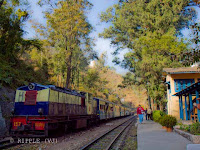Kalka Devi Temple at Kalka, Panchkula, Haryana || A Shrine to the Goddess at the center of Shaktism in Hinduism
Kali is the feminine form of Kaal, or time. She is also referred to as the feminine form of Lord Shiva, who is also referred to as Kaal. Together, they represent the changing time that brings death and decay to all living beings. The name Kali is also used in relation to Kali mata's complexion and can be translated to "The dark mother".
Kali is a female divine force and features prominently in Devi Mahatmya, an important Hindu philosophical text about Shaktism that describes Goddess as the supreme power and creator of Universe. It is part of the Markandeya Puran. In all her forms, Kali is depicted as dark blue (indicating that she is beyond the brahman, with disheveled hair, wearing a garland of severed human heads and with her blood red tongue lolling and her bloodshot eyes glaring.
There are various theories regarding the origin of Kali Mata. In the first chapter of Devi Mahatmya, Brahma invoked her in the form of Mahakali, also known as Yog Nidra, from Lord Vishnu in order to wake him up from his deep sleep, when the two asuras Madhu and Kaitabh were wrecking a havoc on the world. Lord Vishnu engaged in a battle with the asuras for days, but was not able to defeat them. Then Mahakali took the form of Mahamaya in order to enchant the asuras. When the asuras were under her spell, Lord Vishnu slayed them.
Mahakali is the consort of Lord Shiv's incarnation of Mahakal, and is most commonly depicted with ten heads, ten arms and ten legs. In each of her ten hands she is shown holding the the weapon of one God, depicting that she is the source of these powers.
One chapter of Devi Mahatmya showcases Kali emerging from an enraged Durga's forehead. Kali's appearance is dark blue, gaunt, with sunken eyes, disshevelled hair, a lolling red tongue and she immediately kills the asuras, Chanda and Munda, hence earning the name of Chamunda. In the same battle, Kali also defeated the demon Raktabija, who had the ability to clone himself with every drop of his blood that hit the earth. Kali killed him by drinking the blood before they hit the earth.
Another theory of Kali's origin also involves the relatively mild Goddess Parvati. When Lord Shiva asked Goddess Parvati to kill the demon Daruka, she merged with Lord Shiva and emerged as Kali and killed the demon and his armies. But then her bloodlust went out of control and only Shiva was able to calm her down.
Once you start reading about Shaktism, this world keeps drawing you in. You can go to any depth. Once you start reading about the iconography, you start questioning the icons based on which foot they have put forward (right-hand vs left-hand ways) which has huge significance on the interpretations. And then there are so many other threads. I had to pull myself out of this topic deliberately in order to finish this blog. And then I realized that I haven't talked about the temple at all.
The Kali Mata Temple at Kalka is also known as Kalka Mandir. And it is from this temple that the city of Kalka gets its name. The temple is located at a distance of 2 km by road from Kalka Railway Station. As per the legends, during their 12 year long vanvaas, Pandavas stayed at Virat Nagar. They found Kali Mata's pindi here and also noticed that a cow named Shyama used to bathe the pindi daily with its milk. Impressed by this sight, the Pandavas established this temple.
Related Blogposts -








.jpg)
Comments